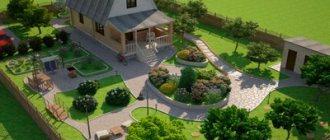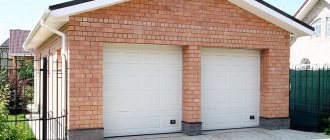Having purchased a country plot, the owners are faced with the need to equip a well. In order for this facility to comply with sanitary and hygienic standards and be safe during operation, it is important to choose the right location for the construction of the mine.
A reader contacted our editorial office who was faced with a similar problem: “I bought an inexpensive plot of land that did not have a centralized water supply. To provide the country house with water, I thought about building a well. I read on the Internet that you need to choose the right place to drill a well. I have a plot of rather modest size, on which a small house is built, and there are outbuildings. How to determine the optimal location for building a well?
We often receive similar questions. We have studied the topic and will provide comprehensive answers to readers’ questions. Next, we will consider the basic legal requirements, building codes and rules regulating this process.
It is advisable to plan the construction of a well before the construction of any objects on the site begins. However, more often it turns out, as in the case of our reader, that the house has already been built and the plot has outbuildings. What to do in this case? You need to carefully consider the site plan. When choosing a location to create a well, the ease of use of the facility is taken into account. It is important that the water intake point is located at an appropriate distance from sources of pollution, as well as other objects.
The well should not interfere with travel or cause damage to nearby objects, including other wells and neighbors’ buildings.
Legal norms
When building a well on a private plot, the requirements of the following legislative acts are taken into account:
- SNiP 30-02-97. This document has been updated in 2021. Now, when constructing wells with water consumption of more than 100 cubic meters per day, it is necessary to register the facility, obtain a license and pay taxes. SNiP specifies recommendations for the construction of facilities on the site. The local administration of SNT or another type of partnership specifies in the regulations the relevant requirements for the location of facilities. When drawing up the charter, the recommendations of SNiP are taken into account.
- SP 53.13330.2011. This guide allows you to determine the correct location for the well on the site diagram. It is used during the development of an allotment plan before the construction of residential and commercial facilities begins.
- SP 31.13330.2012. These rules regulate the construction of sanitary facilities on your own site.
Most often, shaft wells are created in suburban areas. They are built taking into account the water source on the neighboring site. The work of choosing a place to build a well should be entrusted to a specialist . If you do not take into account the depth and volume of the neighbors' water intake point, after construction the water may go into a new well. This will lead to disputes with neighbors. They will win the case in court, and your well will be closed at your expense. Therefore, it is worth carefully approaching the process of choosing a water intake point.
Important nuances
- All requirements regarding how far the toilet should be from the fence are regulated in SNiP, and are also specified in acts of land management organizations and rural or city government bodies.
- The established rules should be strictly adhered to, because violation is fraught with administrative penalties in the form of fines in the amount established by the administrative code. In addition, a toilet placed incorrectly on the premises may be ordered to be demolished and moved to another location. And this, accordingly, additional financial expenses.
- It is worth approaching this issue responsibly so as not to disrupt relations with the people of the neighboring area.
From both a moral and administrative point of view, it is better to live together. After all, today you will cause them discomfort with foreign odors from the septic tank, and tomorrow they can build a stable or install a greenhouse right under your fence. Therefore, this fact must be taken into account. - It is necessary to calculate the distance from the fence to the toilet at the stage of planning the equipment of the land space, so as not to encounter problems and litigation at the moment when all the structures have already been erected and equipped.
It is important to consider all of the above factors in order to remain a good neighbor and citizen, acting in accordance with established legal requirements.
Ideal location
Owners of suburban areas have to follow a whole set of rules when placing allotment objects. It is especially difficult for owners of narrow and small areas to choose the optimal location for drilling a well. An ideally located well should:
- Be located at a sufficient distance from the foundation so as not to cause the destruction of the house due to erosion of the foundation.
- Don't disturb your neighbors.
- Don't be too far from home. Otherwise, a complex communications system will be required, which will be expensive and will become clogged.
- Keep at a sufficient distance from sources of pollution.
- Do not interfere with travel, passages, trees, or garden crops.
- Stay away from the road.
- Be higher than the level of the septic tank (cesspool) on your own and neighboring plots.
- Keep away from objects on the site at the distance established by SNiP.
It is sometimes very difficult to comply with all the requirements. If you can find a suitable place to drill, there is not always water there. This makes finding a suitable location a difficult process.
Problems with neighbors
Today, owners of neighboring houses most often quarrel for several reasons:
- high fence height;
- encroachment of a fence onto someone else’s property;
- darkening of the neighboring area.
Many summer residents sort things out because of the distance between sanitary facilities and their fence. Such buildings include:
- well;
- toilet;
- sauna;
- bathhouse
In order to maintain normal relations and not bring the matter to court, before building a toilet, it is worth discussing the plans with the owners of neighboring plots. It would be helpful to have their written consent to build a toilet near the fence. The most important thing is to comply with all laws and regulations for the construction of a structure.
Distance from foundation
It is easier to choose the optimal location for building a well shaft when the house has not yet been built. If the building already exists, it is worth considering the type of foundation. Shallow foundations of houses are especially affected by the proximity of a well shaft. If the building is built on a strip foundation on clay, the well is made as far as possible.
In accordance with SNiP 30-02-97, the minimum distance from the well to the base of the house is 3 m. But it is better to build a well at a distance of up to 5 m.
This safety measure is necessary, since after digging a mine, the water rises 1.5-2 m relative to the aquifer. Therefore, wells of shallow depth will be the most problematic during operation. Such mines are located in areas where groundwater comes close to the surface. After constructing a well shaft, flooding may occur. The water level will rise and will seep through the walls of the mine.
This leads to erosion of the foundation. Over time, it will collapse, which entails the most undesirable consequences for the building. It is not safe to live in such a house. The well shaft must be properly sealed. It is best to use reinforced concrete rings in this case. When using stone, brick or wood to build a mine, you need to choose high-quality materials for sealing.
Modern standards
The distances between outbuildings must comply with SNiP standards.
Development rules, including the distance between objects, are regulated by the DBN “Planning and Development of Territories.” The rules are slightly different for plots of different sizes. At the same time, the type - individual housing construction, DPN - is not particularly important for small plots, but it limits the type of occupation. It is prohibited to raise cattle on individual housing construction, so it is impossible to build a barn.
Legislative standards
The number of buildings on the site is limited. The main rule of development is: the total area of buildings and sheds is no more than 30% of the total area of the dacha. In this case, the minimum plot area is 500 m². If the area is smaller, construction is prohibited.
The standards regulate not only the location of objects on the territory, but also take into account the placement of buildings near neighbors. If they are already developed, the owner will be forced to study the plan of the neighboring plot to determine the location for his house, barn or garage.
First of all, determine how much you need to retreat from the boundary, fence and street:
- 3 m – minimum distance from the wall to the fence;
- if the neighboring area is built up, reduce the distance to 1 m, but it is calculated not from the walls, but from protruding parts - the roof overhang, for example;
- from the center of a street in a village or a highway to a building on the territory there must be at least 6 m;
- the distance from a regular street is 3 m.
Before building a site, you must obtain permission and notify the local administration about construction work.
Fire regulations
The location of objects on a summer cottage is organized in such a way as to reduce the risk of fire. In this case, the distance is influenced not so much by the purpose of the building as by the materials that were used for it.
The rules are:
- between brick and stone sheds there is a 6 m retreat;
- if the structure is made of stone, but with a wooden floor or roof, the distance increases to 8 m;
- a distance of 10 m is left between the stone building and the wooden shed;
- the distance between 2 wooden buildings of any kind is 15 m.
The specified distances are observed not only between buildings on the site, but also between similar objects on two plots.
Standards within the site
Distances between the fence and outbuildings
The allotment houses objects for a wide variety of purposes: a residential building, a shed for garden tools, a toilet, a bathhouse, a well, a well, a poultry house, a compost pit. Each object has its own standards:
- When building a shed, you should retreat from the fence by 1 m. This is the minimum for any non-residential buildings;
- if a barn is being built for animals, the distance increases to 4 m;
- the utility block is located 3 m from the building;
- poultry house or barn for rabbits - no closer than 12 m;
- the barn is removed 5 m from the center of the roadway;
- the distance between the foundation and the water supply is kept within 3 m.
The exception is residential complexes with an attached utility block. The latter can be a poultry house or even a cowshed. In this case, 2 different entrances are made at a distance of 7 m.
Sanitary standards for construction
When building an allotment, it is important to comply with sanitary and hygienic standards. If the tool shed does not have any impact on the environment, then the poultry house acts as a source of pollution.
The standards are as follows:
- The outdoor shower, toilet, and bathhouse are 8 m away from the house.
- A compost pit is placed at the same distance.
- A poultry house or pig barn has the same impact as a septic tank, so buildings are removed 12 m from a residential building.
- The most important thing is to maintain the distance to the well. Groundwater or rainwater contaminated with bird droppings, entering the well, poisons the water. So such objects are removed from the well or well at a distance of 8 m.
It is necessary to take into account the distances to similar objects on the neighboring plot.
Alternative solution
If the house has not yet been built, you can make a well directly in the building. This solves the problem of removing the well from different objects. The interior layout of the house must be properly designed. The well must be located at an appropriate distance from the foundation.
This solution allows you to save space on the site and reduce the cost of installing a water supply system. First, a well is created on the site, and then a foundation pit is dug. The type of soil and topographical features of the area are taken into account.
The advantages of such a solution are comfort when arranging a communication system for supplying water to a bathroom, toilet, or kitchen. A minimum number of pipes and a pump with less power will be required. This reduces the cost of installing a water supply system.
Building a well inside a house also has a number of disadvantages. For example, if the water supply equipment breaks down, the well needs to be repaired. This may require special equipment that cannot be used in a basement. To periodically clean the shaft, you need to provide sufficient space around the well. Finishing materials in the basement must be resistant to moisture.
Also, building a water intake point inside the house reduces the amount of usable space. Therefore, for our reader who turned to experts for advice, this option is not suitable. He has already built a small house on his plot. Therefore, there is no point in installing a well inside a building.
Method of appealing the installation of a toilet
If it was not possible to resolve the controversial situation, you need to ask for help from the village council by filling out an application. Based on this, a commission will be assembled to check whether the toilet was built legally. On your first visit, the authorities will advise you to move the closet. The second and third time, if the person has not changed anything, it will come down to a fine.
By following all the rules, regulations and laws, you will maintain warm and friendly relations with your neighbors, and you will not be upset by unpleasant odors that reach your home.
Removal from the septic tank
If there is no centralized water supply on the site, then there is no general sewerage system. A septic tank is being installed, which will be an excellent alternative to a cesspool. Modern equipment for autonomous sewerage has many advantages. But it is still a source of possible contamination of drinking water.
To meet the requirements of sanitary and hygienic standards, the septic tank must be located at a distance of at least 20 m from the well (provided that a sealed container is used). Sewage is pumped out over time using a sewer truck. Therefore, the septic tank is located in close proximity to the roadway.
The same requirements apply to your neighbors’ septic tank. Their autonomous sewage system should be located at a distance of 20-50 m, depending on the type of septic tank.
Septic tanks - operating principle and design
Septic tanks are low-capacity wastewater treatment facilities. The main function of a septic tank is to process sewage and waste liquids and transform them into purified, clear and harmless water. There are different types of septic tanks. They differ in power, performance, and methods of water purification.
A septic tank for wastewater treatment is a structure for the mechanical treatment of wastewater by settling with anaerobic digestion of its sludge. (GOST 25150−82, article 44)
Septic tanks are sealed, all accumulations remain inside and, with the help of bacteria, are processed, liquefied and discharged into the drainage system. If the septic tank is in good working order, its contents do not in any way affect the drinking water of wells and boreholes.
Distance from fence
In a suburban area, the fence runs along the street or roadway and along the boundary between plots. There are no clear rules for the distance from fences in modern SNiPs and SanPiNs. However, the recommended distance is 5 m when it comes to fencing between the site and the roadway. This helps prevent contamination of drinking water.
The well can be located at a distance of 1 m from the neighbors' fence. But judicial practice shows that problems do not arise if at least 2 m are removed from the boundary. In this case, the well will not interfere with the neighbors.
Location of communications on the site: norms and rules
Gas pipelines
Here another regulatory document comes into force - SP 62.13330.2011 “Gas distribution systems” (updated edition of SNiP 01/42/2002), as well as PUE (Rules for the construction of electrical installations). They regulate the distance from the gas pipeline (if it is underground or above ground) to buildings and other communications.
Horizontal distances, underground gas pipelines
- Low pressure (up to 0.005 MPa). To the water supply, sewerage, drainage system and power cables of all voltages - at least 1 m, to the foundations of buildings - at least 2 m, from tree trunks - at least 1.5 m.
- Medium pressure (0.005–0.3 MPa). To the water supply system, pressure sewer - at least 1 m; to gravity domestic sewerage, drainage system - at least 1.5 m; to power cables of all voltages – 1 m; to the foundations of buildings - at least 4 m; to tree trunks - at least 1.5 m.
- High pressure (0.3–0.6 MPa). To the water supply system, pressure sewer - at least 1.5 m; to gravity domestic sewerage, drainage system - at least 2 m; to power cables of all voltages – 1 m; to the foundations of buildings - at least 7 m; to tree trunks - at least 1.5 m.
The vertical distance at the intersection of an underground gas pipeline with other underground utility networks does not depend on the pressure in the gas pipeline and is taken as 0.2 m to the water supply, sewerage and drainage. For power cables of all voltages and communication cables – 0.5 m. Laying gas pipelines under building foundations and tree roots is prohibited.
Distances to residential buildings , above-ground (ground) gas pipelines:
- low pressure - not regulated;
- medium pressure - 5 m to buildings of fire resistance class IV and structural fire hazard classes C2 and C3;
- high pressure - 5 m from buildings of fire resistance classes I–IV and structural fire hazard classes C0–C3.
If main gas is not supplied to the village and cylinders are used for domestic gas supply, then with a capacity of more than 12 liters they should be located in an extension made of non-flammable material or in a metal box near a blind section of the outer wall no closer than 5 m from the entrance to the building
Electricity: how to lay cables on site
Distances from cables and wires to various objects are determined by the PUE. The relative position of the cables and the gas pipeline has already been discussed; As for the rest, the standards are as follows.
- When laying cables underground, the distance to the water supply system, drainage system and sewerage system is at least 1 m, buildings - 0.5 m, large trees - 2 m, bushes - 0.75 m.
- If the wires pass through the air, the distance to the tree crowns is at least 1 m.








